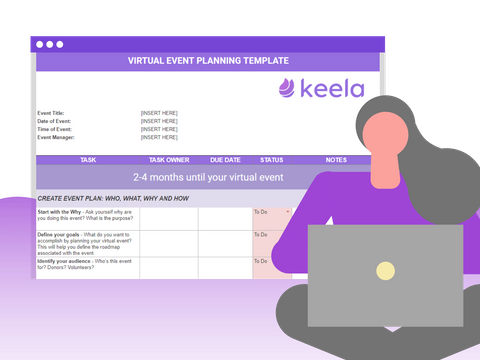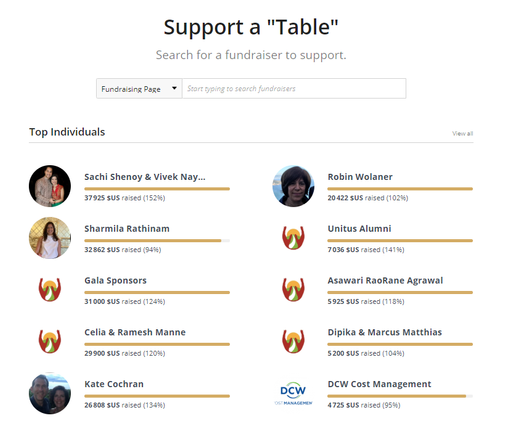A Nonprofit Guide to Virtual Fundraising Events in 2022


Shiny, happy people holding hands in support of a cause, the human spirit of togetherness. The collective feeling of doing something good. These are the things that come to mind when nonprofit professionals plan to host a virtual fundraising event.
But what if you can’t get everyone together in one spot? What if your venue falls through, your supporters live too far apart, or your budget can’t pay for enough space, refreshments, staff, and everything else that comes with an in-person fundraiser? There couldn’t possibly be a way to get the same community spirit without hosting an event where we all breathe the same air, could there?
Beep and boops to the rescue! The internet has stepped up to provide all kinds of solutions for hosting your next virtual fundraising event, so you don’t have to be in the same room as your donors and supporters to be close to them.
What is a Virtual Fundraising Event?
A virtual fundraising event is a fundraiser hosted online. Like any in-person fundraiser, the goal of a virtual fundraising event is to raise money by inviting donors and supporters to stream, participate in, and donate to your nonprofit during a virtual event.
In 2022, virtual fundraising events will offer flexibility for you, as a nonprofit, and your donors. It allows you to meet and connect with more donors where they are while encouraging them to contribute to your nonprofit’s mission.
Virtual Events Can Be Easy, If You Know the Secret
The Benefits of a Virtual Fundraising Event
While the idea of hosting an online fundraising event may be daunting, it comes with a nice set of bonuses that you just can’t get from a traditional fundraiser:
1. Lower Costs
With virtual fundraisers, you don’t have to worry about rental fees, catering, transportation costs, and utilities. You can make the most of your money and time by reducing expenses and focusing on raising more funds through your event.
2. Expand Your Reach
Virtual fundraisers are a great way to reach more supporters and make your event more accessible. Anyone with an internet connection can join your event and contribute to your nonprofit organization.
3. Gather Actionable Data
As attendees share their contacts through your sign-up forms, you can add their information to your donor database. You can get location data, encourage email newsletter signups, and record statistics about your event, like how many people signed up versus how many participated or how many watched your video content versus how many gave to your cause.
4. More Sponsorship Opportunities
In-person events tend to have many sponsors, but the entry barrier can be relatively high. Printing banners, delivering supplies to the site, making t-shirts, the list goes on. Digital sponsorship, on the other hand, can be accomplished as easily as sending a monetary contribution and branding assets. Virtual fundraising events open up sponsorship to smaller companies eager to join your cause but never had the staff or budget to support a live event.
5. Boost Your Donor Engagement
The sheer variety of options for keeping your donors and supporters engaged online is staggering. Many virtual events platforms allow attendees to have conversations, share reactions in a group chat, participate in audience polls, ask questions, and find relevant resources. Use a hashtag to centralize conversations about your event and make it easy for them to find each other. Put a giant thermometer somewhere because people love to donate and see it fill up! Your virtual fundraising event should be part of your process for stewarding prospective and new donors.
6. Content Creation
On many virtual events platforms, you can record your virtual fundraising event and use that recording for future promotions, creating new content, or simply reviewing how the event went. It can sometimes be challenging to capture critical moments with in-person fundraising events, but you won’t miss a thing with recorded virtual fundraisers.
How to Host Your Next Virtual Fundraising Event
The skills you’ve already acquired from planning in-person fundraisers are applicable to virtual fundraising events. If you haven’t organized an event in a while, it’s a good idea to have a look at our article on event planning. Once you’ve brushed up on event planning, let’s get into some of the specifics of virtual events.
Here are a few things to consider as you prepare to host your next virtual fundraising event:
1. Set Goals
Goal setting is an essential first step to setting up a virtual fundraising event. SMART goals put things into perspective and help you to focus on what matters. By establishing your event’s goals and deciding on your target audience, you can work better to put the pieces together to make your event a success.
2. Assemble Your Team
Gather a virtual event team from your staff and volunteers. It’s a good idea to start with people who are comfortable with technology and who all have smartphones that they regularly use to test and use your event platform. Ensure that individual responsibilities are well defined—it’s easy to duplicate tasks online, and you don’t want to end up commenting twice on a Facebook post.
3. Decide on Your Event Format
Once you’ve put together a team to help you bring your virtual fundraising event to life, work with them to decide on an ideal format, framework, and program for your event. During the event, would you like to have a live performance, live podcast, or Q&As? Is it a walk-a-thon or an online auction? How many speakers are needed to make your event a success? You and your team should address these questions and more.
4. Set Up Your Online Tools
From Zoom, GreaterGiving to Airmeet, there is no shortage of online tools for hosting virtual fundraising events. You’ll need online tools for streaming, ticketing, landing page, donation forms, and data management. Your choice of these tools should depend on the goals you’ve set for your event.
5. Promote Your Event
Your promotion plan will look a lot like the one you might use for an in-person event, with one crucial difference: you’re going to have to hammer home the fact that the event is online. Everywhere you promote your event, on social media, advertising, email, or otherwise, make it clear that it’s happening online.
6. Rehearse Your Event
It’s always good practice to conduct a test run of your virtual fundraising events, just like you would for an in-person fundraiser. Use this as an opportunity to work out any kinks, edit down your program, rehearse speeches, test your online tools, and even check your internet connection.
7. Host Your Event
On the day of your event, plan to minimize background noise and dress to impress. The more you treat it like an in-person event, the more professional it will look, which benefits your brand image and bottom line. Assign your team members to moderate the live event, group chat, and offer tech assistance to the occasional attendee who may be having challenges. During the event, acknowledge your attendees as you would at an in-person fundraiser, share housekeeping tips, and keep checking in to make sure they remain engaged.
8. Follow Up
Congratulations, you’ve successfully hosted your virtual fundraising event. The next step is to follow up with your attendees. Use Keela’s intuitive email marketing platform to send thank you letters to your attendees. In your communications, ask your attendees for their feedback and share directions on how they can continue to support your nonprofit.
9. Audit Your Event
The final but most crucial step of hosting a virtual fundraising event is to review and learn from it. After all, there’s always another fundraiser just around the corner. Get your team together, listen to their feedback, and review attendees’ feedback. Watch key parts of the event’s recording, revisit your goals, and make informed decisions on how you can make your next virtual fundraising event even better.


Spread the word about your virtual fundraising event
Use these eight templates to write inspiring donation letters and raise more money.
5 Examples of Amazing Virtual Fundraising Events
There are virtually no limits to your online event, but here are a few fundraising ideas to get you started (in addition to our comprehensive guide on online fundraising):
1. Virtual Gala
Upaya put on a virtual event when they were had to cancel their annual gala. But incredibly, they ended up raising more than their goal amount! Why did it work so well?
They get into the details on their blog, but the main reason it was such a success was that they ran it almost exactly like they would have run their usual gala. With speeches, corporate sponsorship, a live auction, and even table sponsorship, the event sought to move all the major gala elements to the web.
Then they doubled down by adding in a peer-to-peer fundraising element that encouraged sharing and personal fundraising on behalf of Upaya, expanding their reach and pushing their event total over the top.
2. Virtual Charity Run
You might not think that an athletic event for charity would be possible online. But thanks to apps like Strava, it’s now possible to track a run, walk, or bike ride using a smartphone, allowing your supporters to participate wherever it’s convenient: the local track, their backyards, even on a treadmill.
For five months, nearly 800 people helped Running Down Dementia raise money to find a cure for dementia; the top runner traveled more than 500 k.m. on foot! Giving participants the option to run can be a real booster for your virtual run event. There are many ways to encourage competition both in total distance run and funds raised: add a social media forum for (polite) banters, let runners raise money in teams, and display a leaderboard on your landing page that updates regularly.
3. Film Festival
Movies bring people together. Whether fiction or documentary, short or feature-length, a film can reach people with stories and images that touch their hearts, and hopefully, move them to give to a cause.
Global Fund for Women is hosting an ongoing film festival featuring five documentaries and an expertly crafted website that hits all the major engagement strategies: sign up for the newsletter, follow them on social media, host a screening, and of course, donate. Particularly, social media is a great way to get people talking about your cause, especially if you can connect them with the filmmakers.
4. Concert Webcast
Concerts have been a pretty standard feature of nonprofit fundraising. From Live Aid to Farm Aid to the Tibetan Freedom Concert, music will attract many people who don’t care about your cause, haven’t thought about it at all, would usually not give, and yet, they give anyway. It’s a great way to reach many people at once.
Thanks to web-connected services like Facebook Live, neither your audience nor musicians need to be in the same location. While someone performs live from New York City, the audience watches from around the world, and the following actions can be tuning their guitars in Oklahoma City.
Park Sound Studio set an excellent example of accomplishing a benefit concert on a small scale using Eventbrite, featuring local artists, streamed via Instagram Live. They raised money for out-of-work musicians affected by the financial difficulties of 2020 and the Greater Vancouver Food Bank.
5. Virtual Market
How does one move a market to the web? Isn’t half the fun of a market walking around to the various booths and seeing what is on offer?
Arts Market New Orleans figured out a brilliant way to translate the market experience onto the web using a common hashtag, #virtualartsmarket. When support search Twitter, Facebook, and Instagram using this tag, they can visit the individual pages (booths, if you will) of dozens of New Orleans artists, purchase goods, as well as find featured artists, and participate in discussions.
It’s a great model because it enables easy sharing and broad participation outside the immediate geographic area.
If you can’t have your next fundraiser in person, take a technological leap forward and host a virtual fundraising event instead. The only limitation is your imagination.’


Your Next Virtual Fundraising Event Could Be Your Best Yet
Use this FREE planner to help your team visualize how much work needs to be done and what should be prioritized prior to the event.
Donation Letter Templates
Use these 8 Donation Letter Templates to inspire donors
and raise more money.








